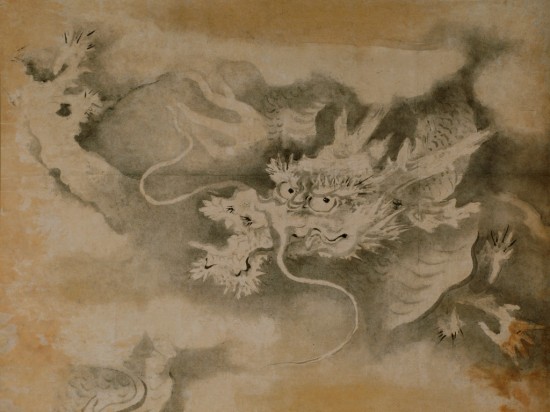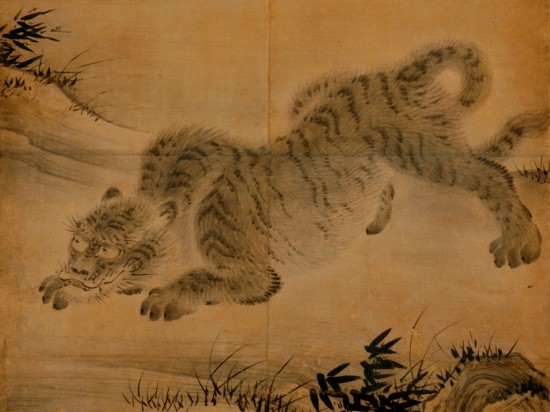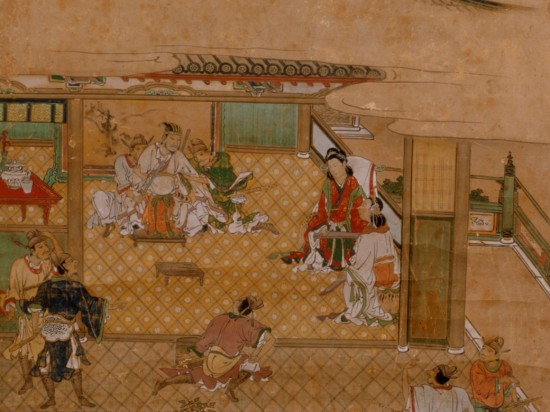From Hara Museum ARC, Gunma
The words “compete,” “fight” and “struggle” describe the spirit behind this exhibition. Here, the power of the confrontation is captured in early-modern era paintings from the Hara Rokuro Collection. These scenes of traditional customs and historical legends and anecdotes present the viewer with the spirit of the fight that is almost palpable.

Kano school, Dragon among clouds (part of paintings used for wallpaper and sliding doors at Nikko-in Mi’idera temple), Edo period, Two hanging scrolls (detail)

Kano Eitoku, Tiger in a bamboo groove (part of paintings used for wallpaper and sliding doors at Nikko-in Mi’idera temple), Edo period, Four hanging scrolls (detail)
In this painting, a tiger is shown body stooped, fur standing on end. Its gaze is turned upward to a small bird perched on a branch of a pine tree. We get the sense of a strong wind blowing, enough to make the tree branches bow. How is the body posture of the tiger and bird depicted? We can feel a tenseness in the picture. In Japan, it is often said that the “clouds form when the dragon roars and the wind blows when the tiger brags.” The pitting of the cloud-forming dragon against the wind-generating tiger was often used as a metaphor for the hero who commands events in the world and was much favored by by warriors during the Warring States period and Zen monks.

Kano Jin’no-jo, Inside view of Xianyang-gong palace (part of a set of twelve hanging scrolls by painters of the Kano school), Edo period, Hanging scroll (detail)
Xianyang Palace was a magnificent structure built by the Duke Xiao in Xianyang, where he had established his capital. The palace was later inhabited by Qin Shi Huang, the first emperor of China. The subject of this painting is an episode from the Assassins chapter of the Records of the Grand Historian. Jing Ke of the State of Yan and Qin Wuyang are planning to execute the captured Qin Shi Huang. As a final request, he asks to hear a song played by his wife Madam Hua Yang on a zither. Jing Ke allows this, but becomes so enraptured by the beauty of the sound that Qin Shi Huang escapes and later kills Jing Ke.
———————————-
Hara Museum ARC Summer Exhibitions
◆Kankai Pavilion (traditional East Asian art)
Excitation of the Spirit
Part I: July 2 (Sat.) – August 4 (Thu.), 2011
Part II: August 5 (Fri.) – September 11 (Sun.), 2011
◆Contemporary Art Galleries A, B and C
The World of Color: Selections from the Hara Museum Collection
July 2 (Sat.) – September 11 (Sun.), 2011
*Special viewing of the open-view storage facility [special tour]
A museum tour by a curator will be offered every Sunday (in Japanese only, starting at 2:30 pm and lasting about 1 hour) during the museum’s exhibition period. The tour will include the open-view storage facility. Participation is on a reservation basis (participants must be junior high school age or older).
Hours: 9:30 am – 4:30 pm (weekend and holidays) 10:00 am – 4:00 pm (weekdays) *last entry 30 minutes before closing
Closed: Thursdays during the exhibition period (open on during the month of August)
*Due to the power supply situation, museum operating hours will be shortened on weekdays until Friday, July 22.
Admission: General (over 12) 1,000 yen; children (over 3) 500 yen; 10% discount for a group of 20 or more.
*Children must be accompanied by an adult
**Combination ticket for Hara Museum ARC and Ikaho Green Bokujo ranch: General 1,800 yen; Children 900 yen
Getting There: By train: Take the Joetsu Shinkansen to Takasaki, change to the Joestu Line, and disembark at Shibukawa. From Shibukawa, ARC is 10 minutes away by taxi or 15 minutes by bus (take the Ikaho Onsen bus to “Green Bokujo Mae”). By car: 8 kilometers (about 15 minutes) from the Kan-etsu Expressway Shibukawa Ikaho Interchange (in the direction of Ikaho Onsen).
———————————-
NEWS
Let’s make art uchiwa (Japanese fan) !
Dates: August 6 (Sat.) &7(Sun.), August 13(Sat.) -16 (Tue.) 10:30-, 13:00-, 15:00- (3 sessions each day)
Fee: 500 yen (cost of material) plus museum admission
Place: Hara Museum ARC
Limited to 20 person per session
■Hara Museum ARC is now participating in MuPon (museum discount ticket system using iPhone application)!
http://www.tokyoartbeat.com/apps/mupon
———————————-
ACCESS
By Train
By JR Joetsu・Nagano Shinkansen
Recommended timetable
・10:12 Depart Tokyo Station→11:01 Arrive at Takasaki Station/ 11:11Depart Takasaki Satation→11:35 Arrive at Shibukawa Station
・11:12 Depart Tokyo Station→12:03 Arrive at Takasaki Station/ 12:20 Depart Takasaki Satation→12:44 Arrive at Shibukawa Station
・12:24 Depart Tokyo Station→13:14 Arrive at Takasaki Station/ 13:31 Depart Takasaki Satation→13:56 Arrive at Shibukawa Station
By JR Joetsu Limited Express Kusatsu
・ 9:00 Depart Ueno Station→10:37 Arrive at Shibukawa Station (No.31 ; operates only on Saturdays, Sundays and holidays)
・10:00 Depart Ueno Station→11:43 Arrive at Shibukawa Station (No.3 ; operates only on Saturdays, Sundays and holidays)
・12:00 Depart Ueno Station→13:45 Arrive at Shibukawa Station (No. 5)
From Shibukawa Station, take the Kan-etsu Kotsu Bus and get off at the station “Green Bokujo Mae.” http://www.kan-etsu.net/r-bus/timetable/shibu-ikaho-1.htm (in Japanese only). ARC is about 7 minute walk from the bus station.
By Car
Take the Kan-etsu Expressway to Shibukawa Ikaho Interchange. Go in the direction of Ikaho Onsen for 8 km (about 15 min.) .
Highway information:
E-NEXCO Drive Plaza http://www.driveplaza.com/ (in Japanese only)
<website> http://www.haramuseum.or.jp
<mobile site> http://mobile.haramuseum.or.jp
<Twitter> http://twitter.com/#!/HaraMuseumARC
